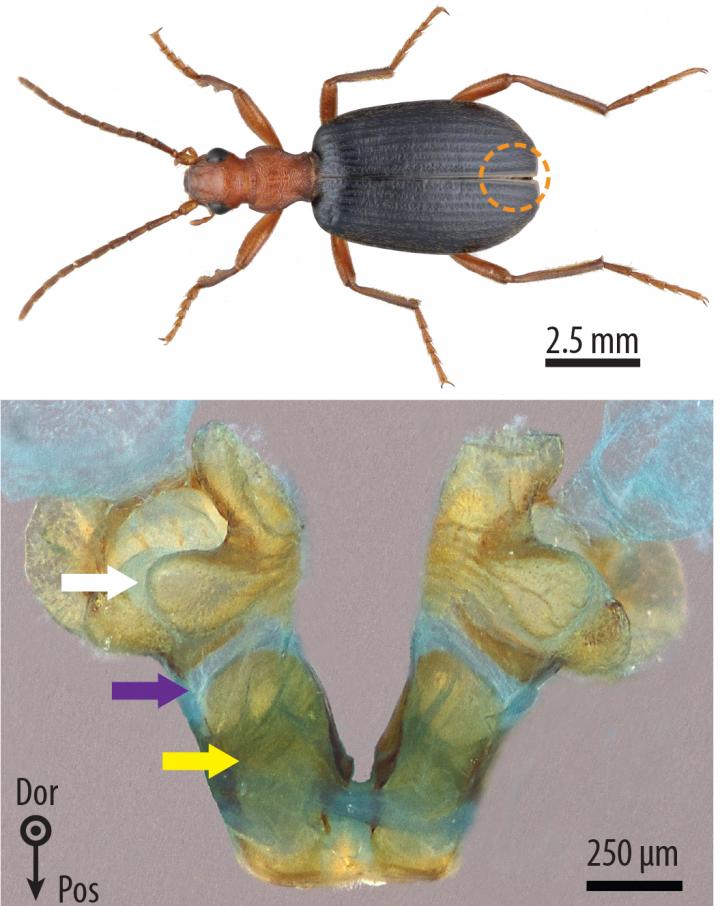Beetlejuice! Secrets of beetle sprays unlocked at the Advanced Photon Source

Researchers used intense X-rays at the Advanced Photon Source, located at Argonne National Laboratory, to study how the bombardier beetle sprays hot, caustic chemicals from two rear glands when threatened. Top: The bombardier beetle can aim its noxious spray from two separate rear glands. Bottom: This colored scanning electron microscope image shows the structure of the two glands. To protect the beetle's insides, the chambers holding the chemicals are lined with a thick layer of protective cuticle, shown in brown. Areas with less cuticle -- and more flexibility -- are shown in blue. The white arrow identifies the reaction chamber; the purple arrow shows the junction between the reaction chamber and the exit channel; and the yellow arrow points out the exit channel dorsal membrane. More info at http://www.anl.gov/articles/beetlejuice-secrets-beetle-sprays-unlocked-advanced-photon-source Credit: Wah-Keat Lee/Brookhaven & Argonne National Laboratories
Researchers using the Advanced Photon Source, a U.S. Department of Energy user facility at Argonne National Laboratory, have gotten the first-ever look inside the living beetle as it sprays. The results are published today in Science.
Scientists and engineers have long been interested in the beetles' rapid-pulse firing–more than 600 times per second–with the intent of stealing the technology: it's been studied for everything from ways to design jet engines that re-start in midair to a deterrent to ATM vandals.
“You could take high-speed photographs of the outside as the spray came out, and you could dissect it to look at the anatomy,” said Brookhaven National Laboratory physicist and former Argonne scientist Wah-Keat Lee, who co-authored the study, “but you really couldn't see inside a living insect until we were able to do this study at the APS.”
“We were not only able to see how the gas and vapor react inside the beetle, but also quantify the reactions that happen,” he said.
“Synchotron X-rays allowed us to visualize the dynamics of explosions as they occurred within the reaction chambers inside of the beetle's bodies. Using this sophisticated, powerful technology, we could finally test previously untestable hypotheses generated by studying the anatomy of dead specimens,” said University of Arizona entomologist Wendy Moore, who specializes on bombardier beetles and co-authored the study.
The beetles store the chemicals in two separate compartments inside their bodies: a reservoir holding most of the chemicals and an armored chamber that contains enzymes to jump-start the reaction. When they're ready to fire, a valve between the two compartments opens and the chemicals react to form a boiling, high-pressure cloud that is ejected with a bang.
“What's interesting,” Lee said, “is that it appears the reaction creates such high pressure that it pushes the valve closed automatically, which readies it for the next pulse. This means the beetle doesn't need a high-speed muscle to repeatedly open and close the valve, and only has to expend energy to open it.” At 600 times per second, that's a lot of energy saved.
This new understanding of how the glands produce–and survive–repetitive explosions could provide new design principles for technologies relating to blast mitigation and propulsion, the authors said.
The GIF at http://www.
“The APS is a powerful tool that allowed an entire new line of investigation into living insects,” Lee said. “There's much more that's waiting to be studied.”
“This research project was incredibly exciting,” Moore said. “It was productive and rewarding to work together with such a truly interdisciplinary team of researchers.”
###
The paper, “Mechanistic Origins of Bombardier Beetle (Brachinini) Explosion-Induced Defensive Spray Pulsation,” was published in Science on May 1 at http://www.
The study was supported by the U.S. Army Research Laboratory and the U.S. Army Research Office through the MIT Institute of Soldier Nanotechnologies; by the National Science Foundation; by the U.S. Department of Defense; and by the U.S. Department of Energy's Office of Science. The Advanced Photon Source is a DOE Office of Science User Facility.
Other study authors were MIT's Christine Ortiz and Eric Arndt and the University of Arizona's Wendy Moore.
Argonne National Laboratory seeks solutions to pressing national problems in science and technology. The nation's first national laboratory, Argonne conducts leading-edge basic and applied scientific research in virtually every scientific discipline. Argonne researchers work closely with researchers from hundreds of companies, universities, and federal, state and municipal agencies to help them solve their specific problems, advance America's scientific leadership and prepare the nation for a better future. With employees from more than 60 nations, Argonne is managed by UChicago Argonne, LLC for the U.S. Department of Energy's Office of Science. For more, visit http://www.
DOE's Office of Science is the single largest supporter of basic research in the physical sciences in the United States, and is working to address some of the most pressing challenges of our time. For more information, please visit science.energy.gov.
Media Contact
All latest news from the category: Life Sciences and Chemistry
Articles and reports from the Life Sciences and chemistry area deal with applied and basic research into modern biology, chemistry and human medicine.
Valuable information can be found on a range of life sciences fields including bacteriology, biochemistry, bionics, bioinformatics, biophysics, biotechnology, genetics, geobotany, human biology, marine biology, microbiology, molecular biology, cellular biology, zoology, bioinorganic chemistry, microchemistry and environmental chemistry.
Newest articles

Can lab-grown neurons exhibit plasticity?
“Neurons that fire together, wire together” describes the neural plasticity seen in human brains, but neurons grown in a dish don’t seem to follow these rules. Neurons that are cultured…

Unlocking the journey of gold through magmatic fluids
By studying sulphur in magmatic fluids at extreme pressures and temperatures, a UNIGE team is revolutionising our understanding of gold transport and ore deposit formation. When one tectonic plate sinks…

3D concrete printing method that captures carbon dioxide
Scientists at Nanyang Technological University, Singapore (NTU Singapore) have developed a 3D concrete printing method that captures carbon, demonstrating a new pathway to reduce the environmental impact of the construction…



